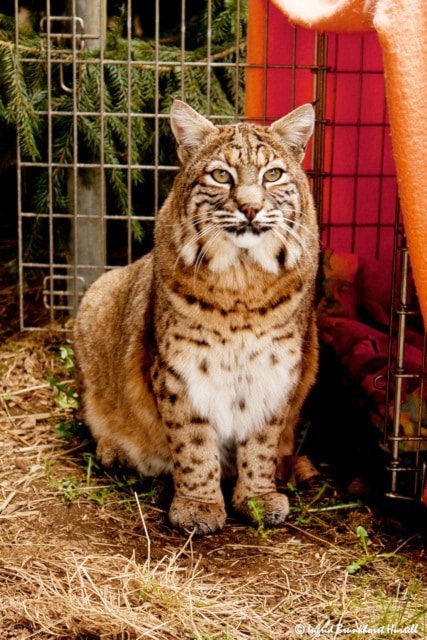Have you ever seen a raccoon yawn?
Did you known that baby skunks can start spraying when they are only eight days old? I was surprised to learn some of these facts, and yes, I actually did see a raccoon yawn as we were photographing it while visiting the Critter Care Wildlife Society (CCWS) on 216 Street recently.
Rescue, Rehab and Release
The CCWS was founded in 1984 by Gail and Richard Martin, who started this work in their home. During the first year, 33 critters were released back into the wild.
In the following years, after 360 animals had been rescued, they moved onto a five acre plot adjoining Campbell Valley Regional Park.
Bear Country
The CCWS even cares for animals as large as black bear cubs. This year has been especially bear-filled, with 16 bear cubs in care at the moment. Most were beginning to come out of hibernation when I visited. One cub in particularly has quite the sad story. It was found on a highway, lying next to the carcasses of its mother and sibling that had been killed by a vehicle. When it was brought to the facility it weighed only eight pounds. Months later he is a healthy 150 pounds and is getting ready to be released this year with the other cubs.
Other Critters
During any given year, CCWS receives a wide variety of animals. Coyotes, beavers, river otters, skunks and squirrels among them.
They recently rescued a batch of bunnies that are so small that a startling sound could cause a fatal heart attack.
Though their goal is to release the animals, the society hs a few pesky critters that won’t leave.
Ms. Kitty, the raccoon has been at CCWS for 10 years. She suffers from epilepsy, preventing her from returning to the wild.
But she’s no moocher – she earns her keep by caring for some of the annual raccoon orphans, though she can be quite picky with her choice of babies.
Another resident happens to be the mascot of Brookswood Secondary School – Hoover the bobcat. Hoover has lived there for more than 11 years, and is very happy.
Internships
The facility has only three paid staff, and so it is run by its interns and volunteers. The interns come from countries all over the world such as Australia, Germany and Britain. Their internships last from two to six months. They live on site and give continuous care to the animals. Most come to gain experience in the hopes of becoming a veterinarian one day. They do all sorts of jobs such as preparing the food trays for the animals' lunches and bottle-feeding the babies.
Traumatized animals
One thing I wanted to know from Val Bouey, the volunteer coordinator I interviewed, was how deeply animals can be traumatized. So many stories of rescue animals after the tsunami in Japan have surfaced — one being the dog rescued out at sea on the roof of its owner's house, three weeks after the earthquake. She told me that animals all respond in their own way to trauma. Deer can become violent and start kicking, bears will start climbing the cages in a fearful attempt to get away from the rescue helpers or even taking a swipe at them.
“One baby cougar was so traumatized, that it ran to the (rescue) volunteer and jumped into this person’s arms," Bouey said. Every animal will react differently to trauma.
On the other hand, when domestic animals are traumatized, they have better coping methods as they have loving owners, food, shelter and warmth. Wild animals have to fend for themselves — something which may be near-impossible for an orphaned newborn.
The earthquake and tsunami in Japan will have caused massive disruptions to habitat, food and eco-systems, Bouey concluded. “Animals who are severely traumatized, may even stop breeding,“ she said.
How To Help
Spring always means babies — lots of them. This year is no exception.
Volunteers are always needed at CCWS. This could involve gardening, painting, fund-raising, marketing, public education, food prep for the animals, laundry, (otters go through a lot of blankets), construction and other tasks.
Donations are always welcomed, whether it’s cash or items such as blankets, towels, food, cleaning supplies and tools. Often, someone is needed to pick-up a new litter of baby skunks or squirrels from a local S.P.C.A.
In general, the public should be aware of how Mother Nature works. For example, finding a litter of babies in a forest, does not necessarily mean they have been orphaned or abandoned. The mother might be off foraging for food. “Keep them under observation for up to 24 hours before attempting to intervene,” Val said.
On Critter Care’s website, clear guidelines are provided about what to do when you find a mammal that is sick, injured or possibly orphaned.
Open House: July 9-10.
This will be a rare opportunity for the public to view the facilities at this unique wildlife rehabilitation centre. Open House is scheduled from 11 a.m. to 4 p.m. on the weekend of July 9-10. Last year, about 4,000 people attended the open house at 481 216 St.
Critical Care
To get involved, contact Val Bouey at 604-530-2054 or visit the website for CCWS at www.crittercarewildlife.org. It often only takes one person to make a difference. My visit to CCWS was for the purpose of writing an article as a writing assignment. It has now changed to potentially applying as a volunteer. If we all do our bit, we can make a difference.
Dustin Hurrell is a Grade 11 student at Langley Fine Arts School. Currently majoring in writing, he enjoys math, physics and science and wants to become a medical doctor.
